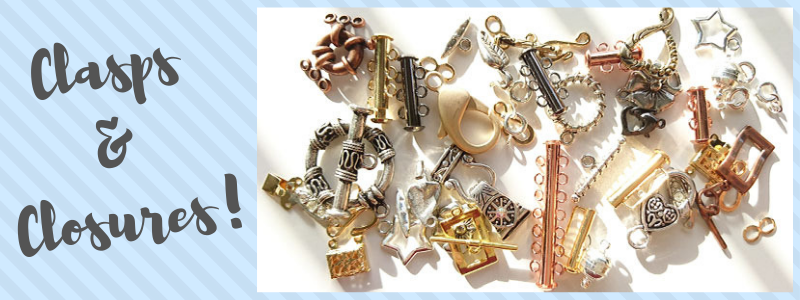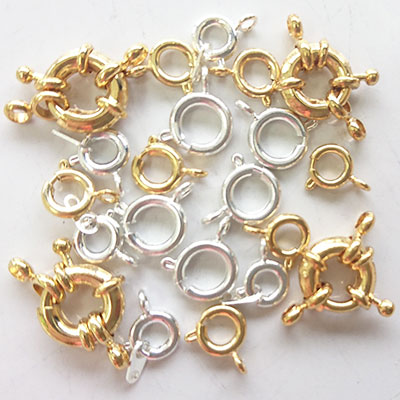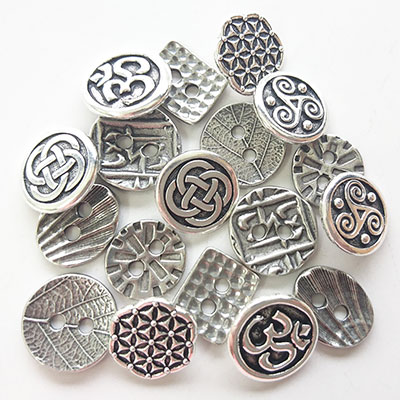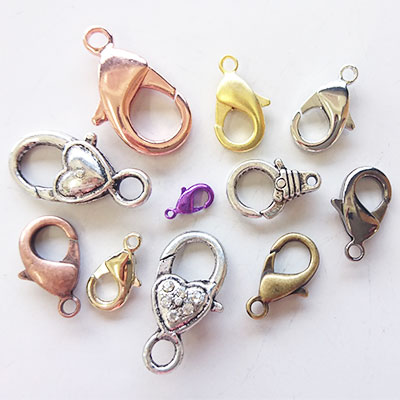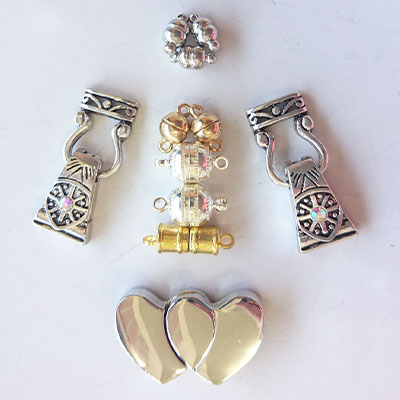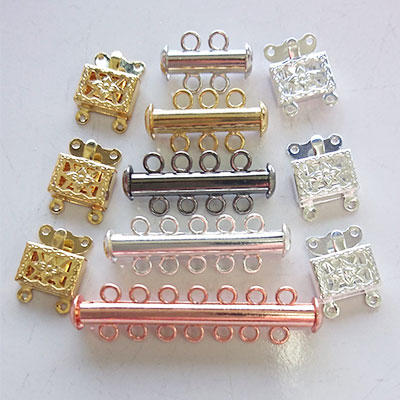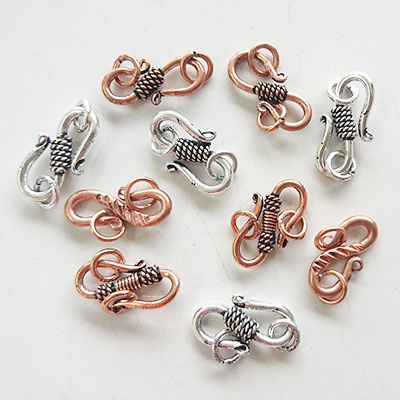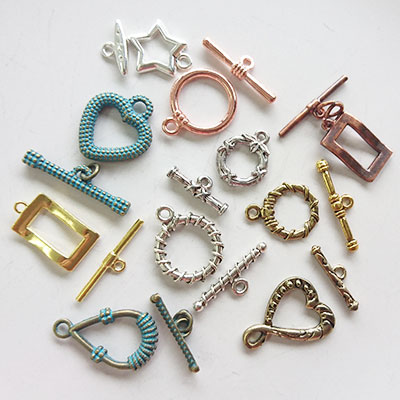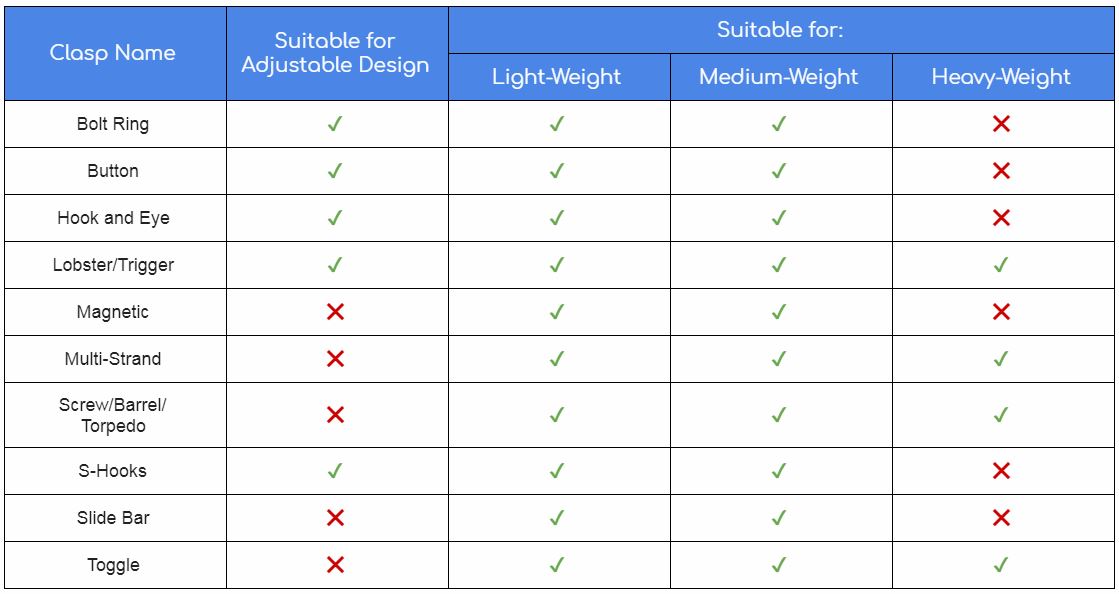Don't you just hate it when you almost finished a project or design, only to be let down by the choice of clasp offered or used? Maybe it wasn’t quite strong enough to support your design? Or it was too big or too small to be balanced properly? Perhaps the colour or finish just wasn’t quite right?
Whatever the reason, the clasp is an integral part of your necklace, bracelet or anklet design, and should be treated as another element of the overall design.
So what should you be considering regarding your choice of clasp when you’re making something beautiful? Well, a few things really! In the past have you considered the following?
- The overall ‘physical’ weight of your beads or cord (as opposed to the ‘weight’ of your design) - It goes without saying that heavier beads need stronger clasps, whereas finer or delicate designs can carry off a dainty clasp
- The ‘weight’ or balance of your design - Your choice of clasp should be in keeping with the size and balance of your design, so bigger beads would probably need a bigger clasp (but the strength of the clasp may not be as important)
- The monetary cost of your beads or focals - If you’ve spent a small fortune on making a bespoke piece (and let’s face it, who hasn’t?!), then using a high quality or specialist clasp is in order
- The location of your clasp - Will it sit at the back on the neck or the underside of the wrist? Is the clasp going to be a focal of the necklace instead? Wherever you choose to put it, it needs to be comfortable and in keeping with the rest of the design
- The type of jewellery ‘vs’ ease of using the clasp - Will whoever is wearing your jewellery be able to secure the clasp themselves e.g. screw clasps on a bracelet can be hard to do up yourself, whereas a magnetic or slide bar clasp is much easier
- How your design will be attached to your clasp - An easy one to overlook! Will your beads be directly attached to the clasp or will they be finished with a crimp, callotte or jumpring? What happens if your clasp breaks? Is it easy to fix without unpicking your whole design?
- Whether the clasp should be adjustable - Some designs can lend themselves to being different lengths so if you this to be an element of your piece, consider what you can add to your clasp to make it easier to adjust for your wearer
Nowadays there are more clasp choices than you can shake a stick at, and it can be confusing deciding which ones to use, so we’ve pulled together this handy list that’ll help you understand the differences between them all.
Pssst... Want to see a quick overview of our clasps? Scroll down to see our comparison table!
Bolt Rings/Spring Rings Bolt Ring clasps (sometimes known as Spring Rings) are one of the most common forms of clasp as they are easy to operate, reliable and durable. They have a sprung trigger mechanism which allows the clasp to closed once the trigger is let go. Due to their size they are best used on light to medium weight jewellery designs and are perfectly priced to keep design costs down. Bolt Rings are available in many sizes (from 6mm - 11mm on our website, but we can also source them from 5mm - 15mm too!) and look great with almost any necklace, bracelet or anklet. The larger sized Bolt Rings tend to be more decorative and heavier, which can look great with oversized jewellery. Some Bolt Rings also come with a tag style ring component, making them a complete clasp, however if they don’t you can easily use a jumpring in its place. This also means the Bolt Ring clasp can be incorporated into an adjustable design, as you can use join multiple jumprings together to give your adjustable section. |
Buttons Perhaps one of the oldest forms of closures! Using a button as a clasp works in a similar way to a Toggle clasp, in that the button is used in place of the toggle, and a beaded ring is used as the ring that the button passes through. Using buttons means you can really customise your clasps to your designs to create a cohesive and bespoke piece. We supply metal buttons made by Tierracast in the USA. They are formed from a very high quality pewter with a choice of finishes and are ideal for completing heavier or knotted styles of jewellery; just ensure the design doesn’t distort the beaded ring closures. Buttons can be used in adjustable designs, as you can add multiple loops of beaded rings, however be sure that these loops add to your design, and are not irritating or annoying to the wearer. |
Hook and Eye Hook and Eye clasps are as they sound - a hook at one end of the clasp and an eye loop at the other and they work by passing the hook through the eye to close the piece. They are extremely easy to use but as the closure isn’t as secure as a Bolt Ring or Lobster clasp, they tend to work better on necklaces, where the weight will keep the hook ‘pulling’ against the eye. They may be more of a risk of them coming apart on a bracelet or anklet as gravity might not keep the clasp elements ‘pulling’ against each other. Depending on the 'eye' section, these clasps may be able to be used in adjustable designs. |
Lobster or Trigger Lobster clasps are so named as they look like a lobster claw, and as such have a strong grip! Similar to Bolt rings, they work with a sprung trigger mechanism but unlike Bolt rings, they tend to be heavier, stronger and a touch more expensive. Lobster clasps are a very versatile and come in a variety of sizes, colours and finishes (from 9.5mm - 27mm on our website, and can source them as small as 5.8mm). Larger Lobster clasps tend to be more ornate and should be used in heavier designs, whereas smaller Lobster clasps work better in lighter designs. These type of clasps are a popular choice for necklaces, bracelets and anklets and lend themselves beautifully to adjustable designs as you can fasten them to lengths of jumprings. However you will need to consider the type of jumpring that you will use, as the trigger of the clasp opens inwards and can make it difficult to use with larger or thicker jumprings. |
Magnetic Magnetic clasps rely on hidden magnets in two halves of a clasp to keep them closed. They are often easier to use than other types of clasps, and can be particularly useful for people with visual problems, arthritis or other dexterity problems. However it is recommended that jewellery with magnetic clasps should never to be worn by anyone who has a pacemaker or other electric cardiac device. Magnetic clasps come in array of designs, from small and functional to large and decorative, so the chances are there is some sort of magnetic clasp out there to suit any design and budget. Magnetic clasps work best when used for light, and middle weight jewellery pieces, but choose carefully as some magnetics might not be strong enough to carry the weight of heavier pieces. Some other standard clasps now also have a magnetic element incorporated, such as the Magnetic Slider clasps. There are brilliant for multi-strand designs, as the magnet in the centre of these slider clasps hold much more securely in place than their non magnetic counterparts. Magnetic clasps are not suitable for adjustable designs. |
Multi-Strand Multi-Strand clasps allow you to create necklaces, bracelets and anklets using a number of strands in the design, perfect for creating repeating patterns of bead strands or a layered look. There are many different styles of clasps that can be used for this, and we carry both Multi-Strand Sliding clasps (with 2 to 7 strands) and Multi-Strand Box clasps (with 2 or 3 strands) The Multi-Strand Sliding clasps consists of two hollow tubes that slide together securely. On a bracelet they can be a little difficult to do up yourself, however they are really easy to use on necklaces and anklets. The Multi-Strand Box clasps are connected with a small piece that slides securely into a groove in the other half of the clasp and can be used on necklaces, bracelets and anklets. The Multi-Strand Box clasps are fine for light and medium weight pieces, whereas the Multi-Strand Sliding clasps are fine for light, medium and heavy weight jewellery. However, Multi-Strand clasps are unable to be used in adjustable designs. |
Screw Barrel or Torpedo These types of clasps are very similar in appearance, shaped like a barrel or torpedo, and screw together to form a very secure clasp. They tend to be smaller and more budget friendly, but their use can be a little limited as they are very hard to do up in a bracelet. We would only suggest using them in designs where you can use both hands easily to secure your jewellery. They are more suited to light and medium weight jewellery but cannot be be used in an adjustable design. |
S-Hooks Similar to Hook and Eye clasps are S-Hooks, where the hook is shaped like an 'S'. One end of the S is attached to your design, whilst the other end hooks onto the other end of your design, usually with a jumpring. They can be opened by pulling slightly on one arm of the 'S' and then closed by pushing it back (however some S-Hooks won’t need this, depending on how ‘open’ the S is). Again, like Hook and Eye clasps, S-Hooks aren't as strong as a lot of other clasps and shouldn't be used with heavy weight designs. Instead, S-Hooks work best with light to medium weight designs where the weight and gravity help to keep the clasp elements in tension against each other Hook and Eye and S-Hooks can be very easy to make yourself using just pliers and/or Findings Forms and Artistic Wire. This is a great alternative if you want a bespoke clasp in bright or unusual colours, and if you are comfortable working wire, you can really make them ornate and detailed, as well as adding that one-of-a-kind (or OOAK as we say in the trade!) feel to your pieces. |
Slide Bar Slide Bar clasps are hollow tube shapes that slide together to close. The difference between these and the Multi-Strand Sliding clasp is that they have an open bar instead of separate eyes for each strand. This means they are perfect for peyote stitched and brick stitched work, but can be used with any other stitch that can wrap around the bar and be stitched back to itself to secure it to the clasp. They come in a variety of metallic colours and sizes, and tend to be best for light to medium weight jewellery, but cannot be used for adjustable pieces. |
Toggle Toggle Clasps, similar to Buttons, are a great choice for necklaces because the weight of the beads help keep the clasp shut. The toggle part of the clasp (usually a bar) passes through the ring of the clasp to secure your jewellery, and these toggles and rings can be very simple or highly decorative. They tend to work best with heavier jewellery as tension is needed to keep the toggle pulled close to the ring. For use with bracelets toggle clasps work very well with heavy, chunky gemstones and ceramic beads, however they can be a little difficult to do up yourself. You need to make sure the toggle part has a good overlap of the ring to help keep it secure, and that it can pass easily up through the ring. Toggle clasps can be easily incorporated into a design where you want the clasp to be a main focal piece, as there is a huge variety of styles, shape, colour and finishes available, including some really eye catching and quirky ones. As the bar is used for closing the clasp, these are not suitable for an adjustable design. |
Now you can finish your design to your heart’s content, safe in the knowledge that you’ve picked the right clasp for your amazing work!
We stock over 300 different types of clasps in different sizes, colours, finishes and prices to suit any budget and design.
Come and check out our range in our New Forest Bead Shop or online here

